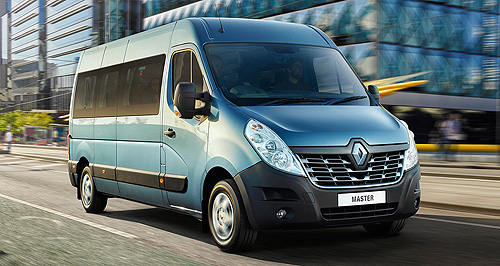All aboard the Renault Master Bus
BY ROBBIE WALLIS | 11th Jan 2016

The Master Bus is priced from $59,990 before on-road costs and has swapped out cargo space for seating for up to 12 people.
Renault's latest addition will compete against the Mercedes-Benz Sprinter Bus, LDV V80 Bus and the segment-leading Toyota HiAce Bus.
Based on the L3H2 long-wheelbase Master van, it uses the same 2.3-litre turbocharged four-cylinder engine teamed with a six-speed automated manual transmission.
The diesel unit is powered through the front wheels and puts out 110kW/350Nm of power, and is compliant with Euro-5 regulations.
Renault's Master Van comes with a 1252kg payload, 2500kg towing capacity, and is rated to carry 200kg on its roof.
The Bus comes with a rated 3.9-tonne gross vehicle mass (GVM), and 1880mm of headroom, which Renault says is enough for an average-sized Australian male to stand fully upright without his head touching the ceiling.
The passenger seats are accessed through a left-side sliding door, and on the rear are two barn doors that use a 270-degree opening function that allows the doors to fold back against the body sides to help loading.
Three seats in the front are teamed with nine in the back, consisting of two seats in the second row, three in the third (divided by a centre aisle), and four across the back. Behind the last row of seats is a luggage area with 3500 litres of space.
Each seat is fitted with seatbelts, while two seats are fitted with Isofix connections and child seat top tether straps.
Other features include a glazed emergency hatch in the roof, reclining seat backs for the two middle rows, hard-wearing vinyl flooring, original equipment-quality interior trim mouldings, durable, soft two-tone grey jacquard fabric seat facings that match the front seats, and an auto side step below the sliding door that slides out when the door opens, as well as a passenger compartment air-conditioning unit to go with a standard front-mounted unit.
The Bus will be offered with two option packs, the Premium Pack and Luxury Pack.
The Premium Pack, which will be available for purchase upon release, adds an electrically powered sliding left-hand side door, auto headlights and rain-sensing wipers, R-Link enhanced satellite navigation with touchscreen, hands-free entry, four USB charging sockets, LED roof lighting, side and rear window curtains, premium carpeting and reclining rear row seats.
The Luxury Pack, which will go on sale later in 2016, adds the contents of the Premium Pack and leather upholstery for all seats, lane-departure warning, storage under the front passenger seat, an alarm, automatic high/low beam headlight function and dark tinted windows.
The Premium Pack will add $3590 onto the starting price for the Master Bus, while equipping the Luxury Pack will set the buyer back $7990.
The Master Bus will be sold with a choice of seven solid and three metallic colours, and Renault is working on a version of the Bus without seats or an elevated floor, so that it can potentially be paired with wheelchair-accessible equipment.
Renault Australia LCV model line manager Lyndon Headley said that there was a gap in the Australian market that the company believes the Master Bus can fill.
“We’ve decided to bring the Master Bus to the Australian market because we recognise the demand for an affordably-priced, high quality, well-equipped, comfortable and spacious bus that requires no compromises by customers or passengers,” he said.
“Renault has long been a supplier of buses for hotels, schools, aged care and private transport companies across Europe, and we are pleased to be able to offer this product to similar customer groups here in Australia in 2016.
“We have spent 18 months talking to prospective bus customers and refining the product, to ensure it is suitable for Australian driving and loading conditions, and to meet the expectations of the Australian market in terms of features, equipment and price.
“The Master Bus is produced in large numbers in Europe so it is built to a predictable and high level of quality. Significant effort has been put into assembly and quality assurance to ensure a long and trouble-free working life.”The Master Bus comes with a three year, 200,000km warranty and goes on sale on January 7.